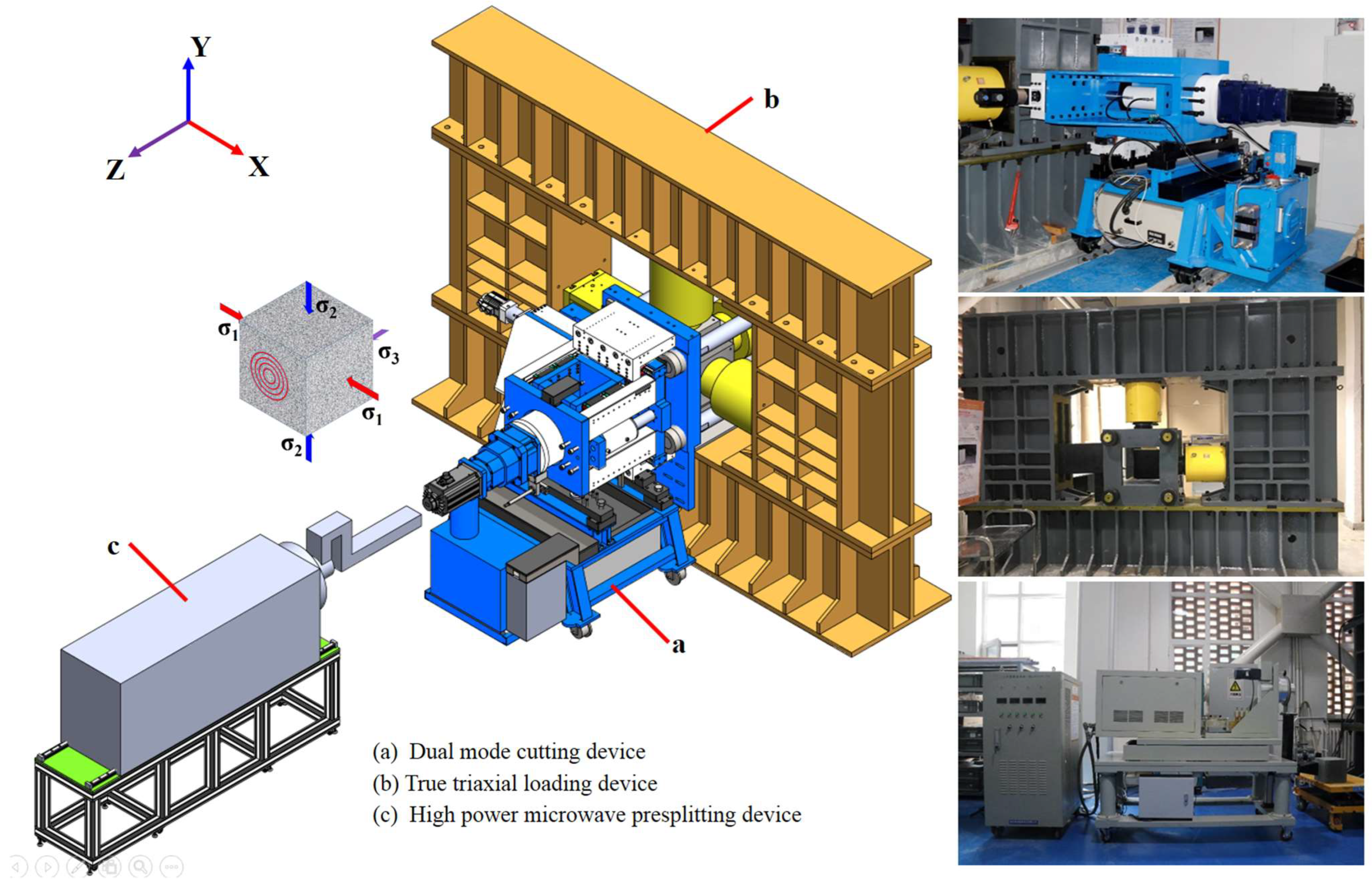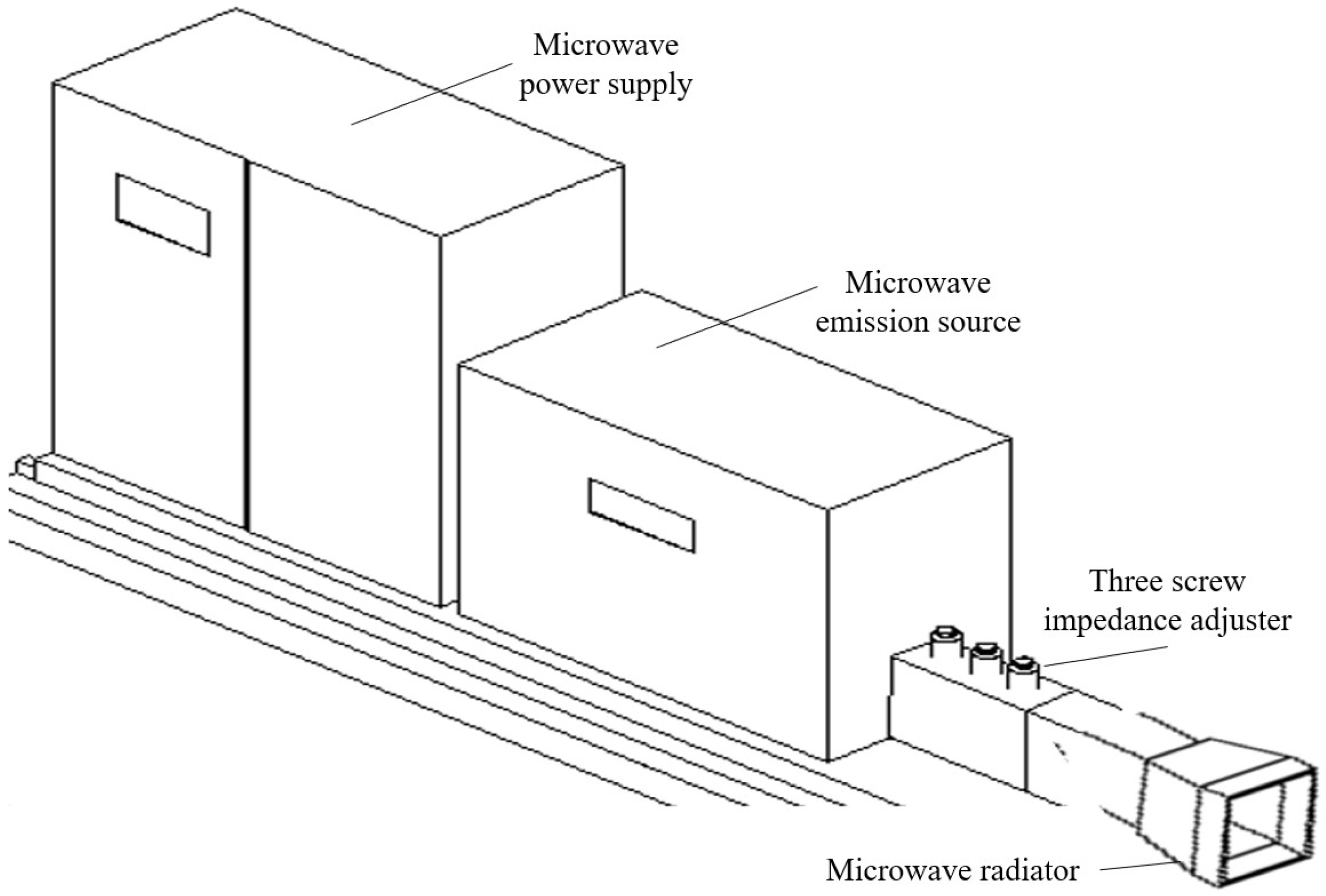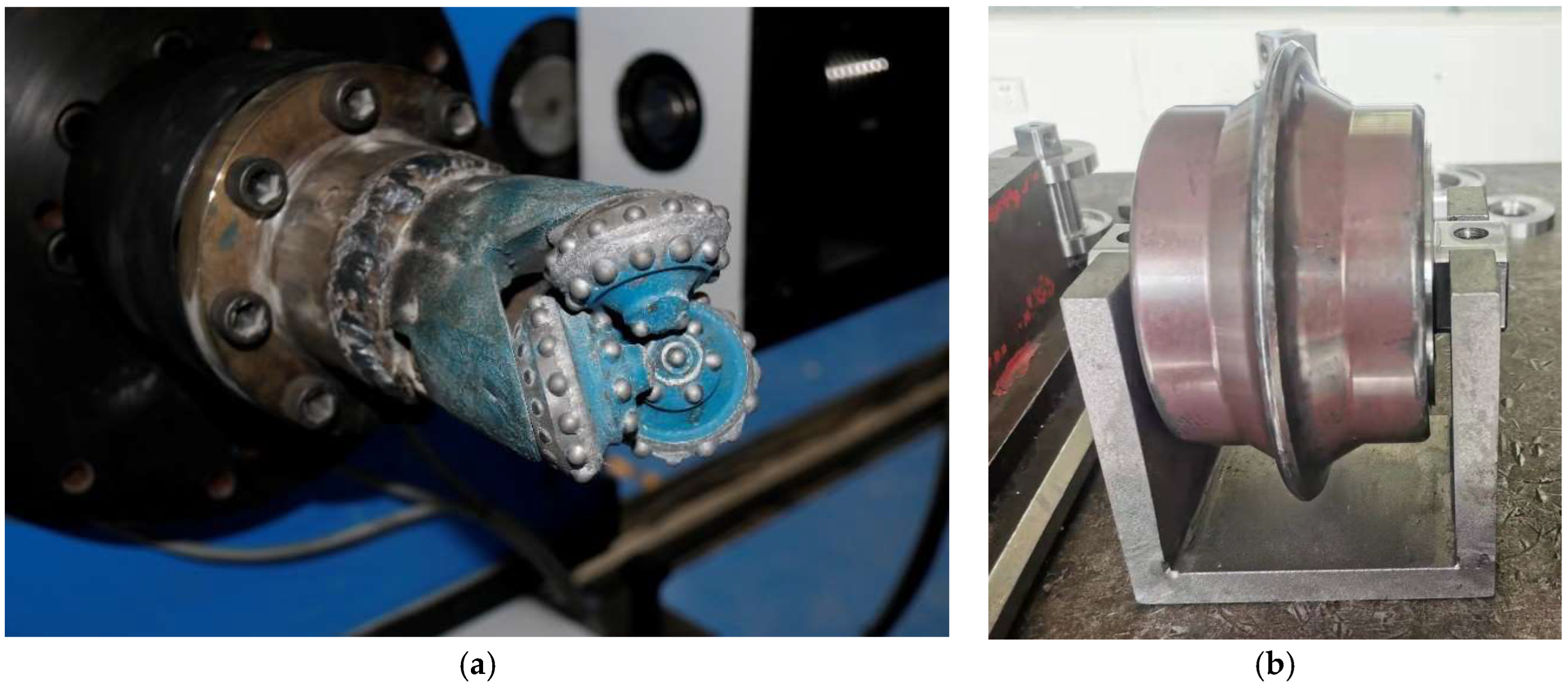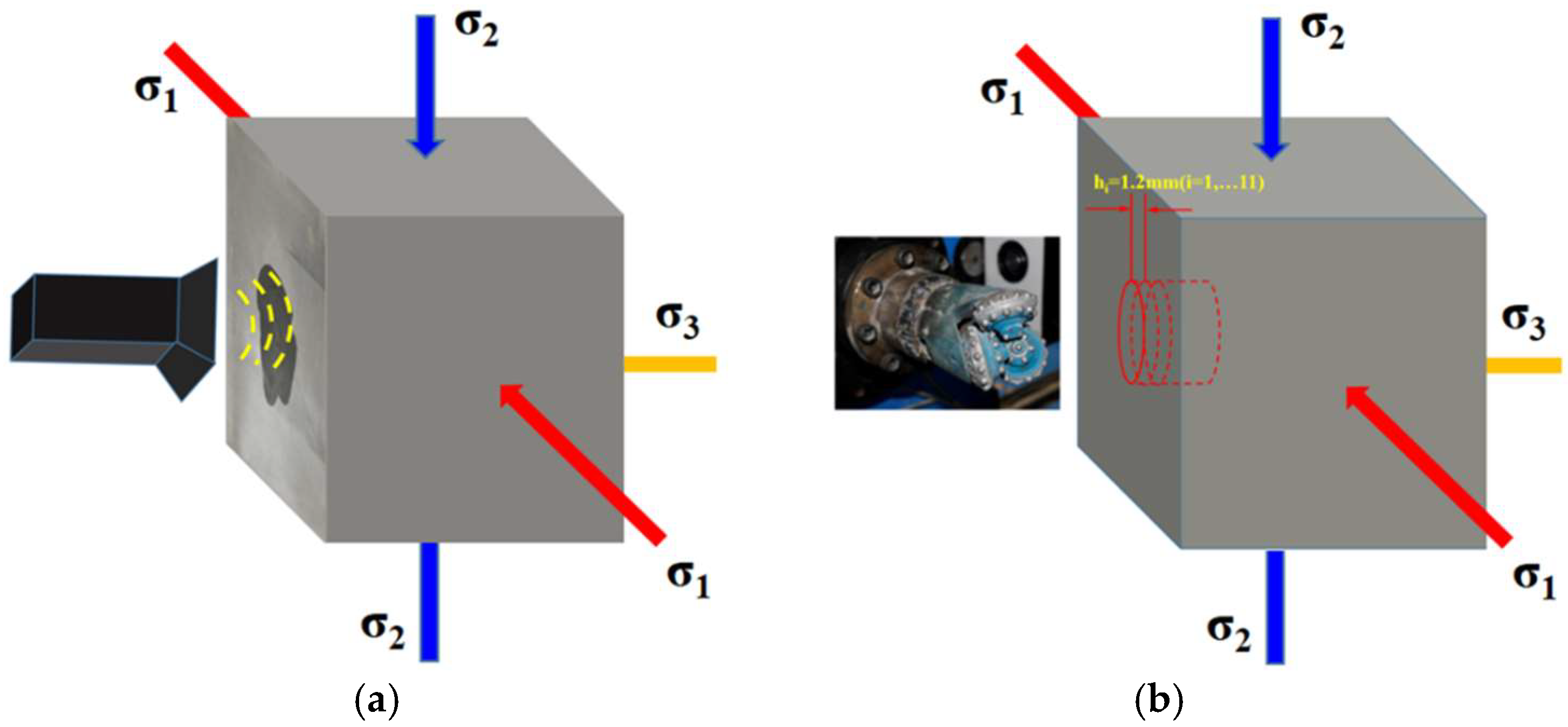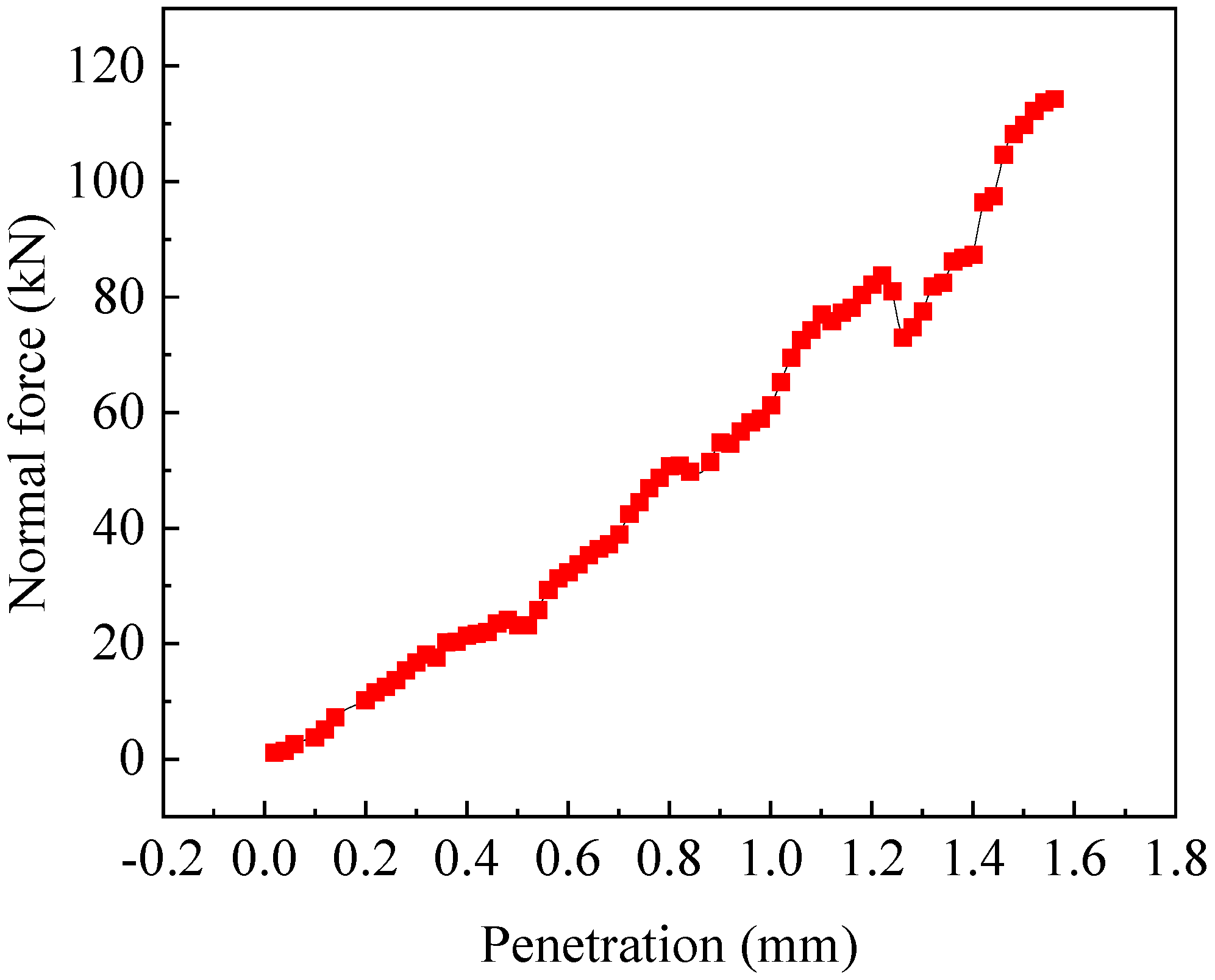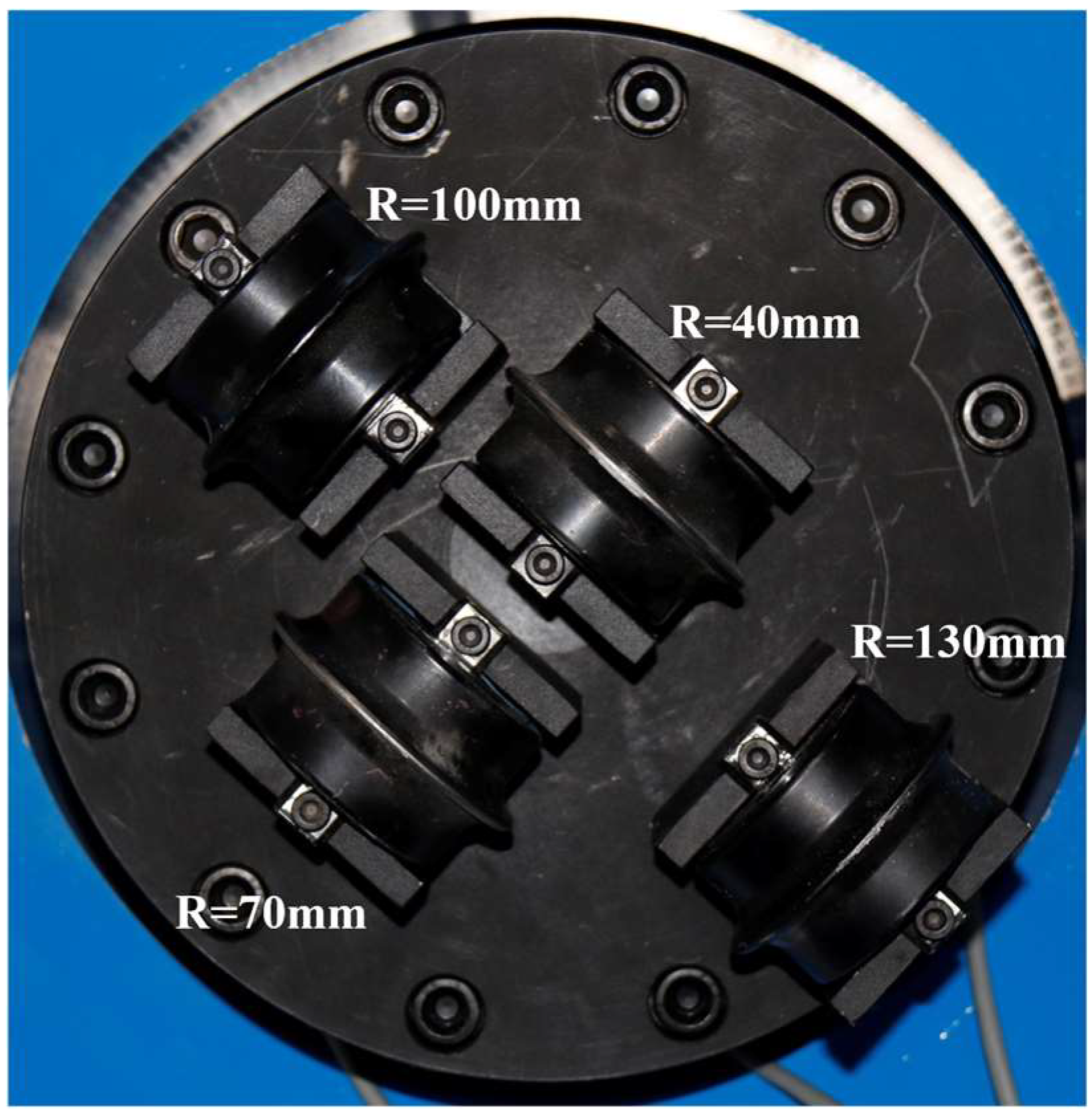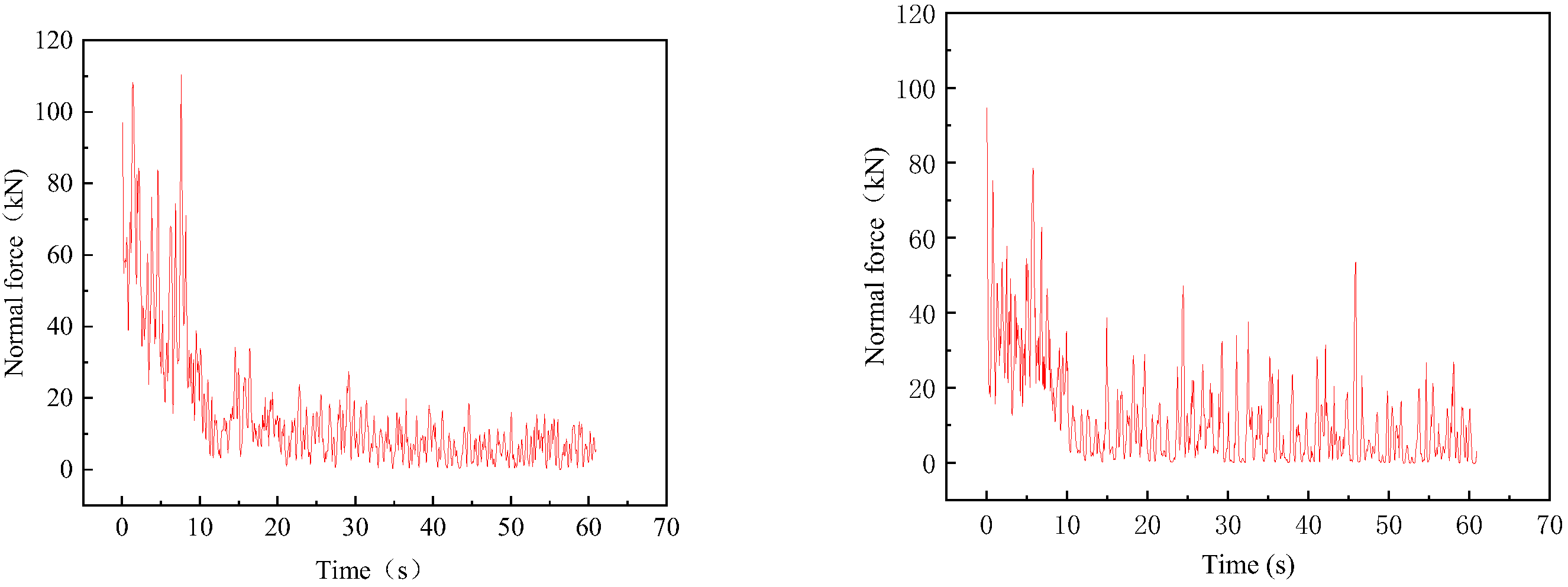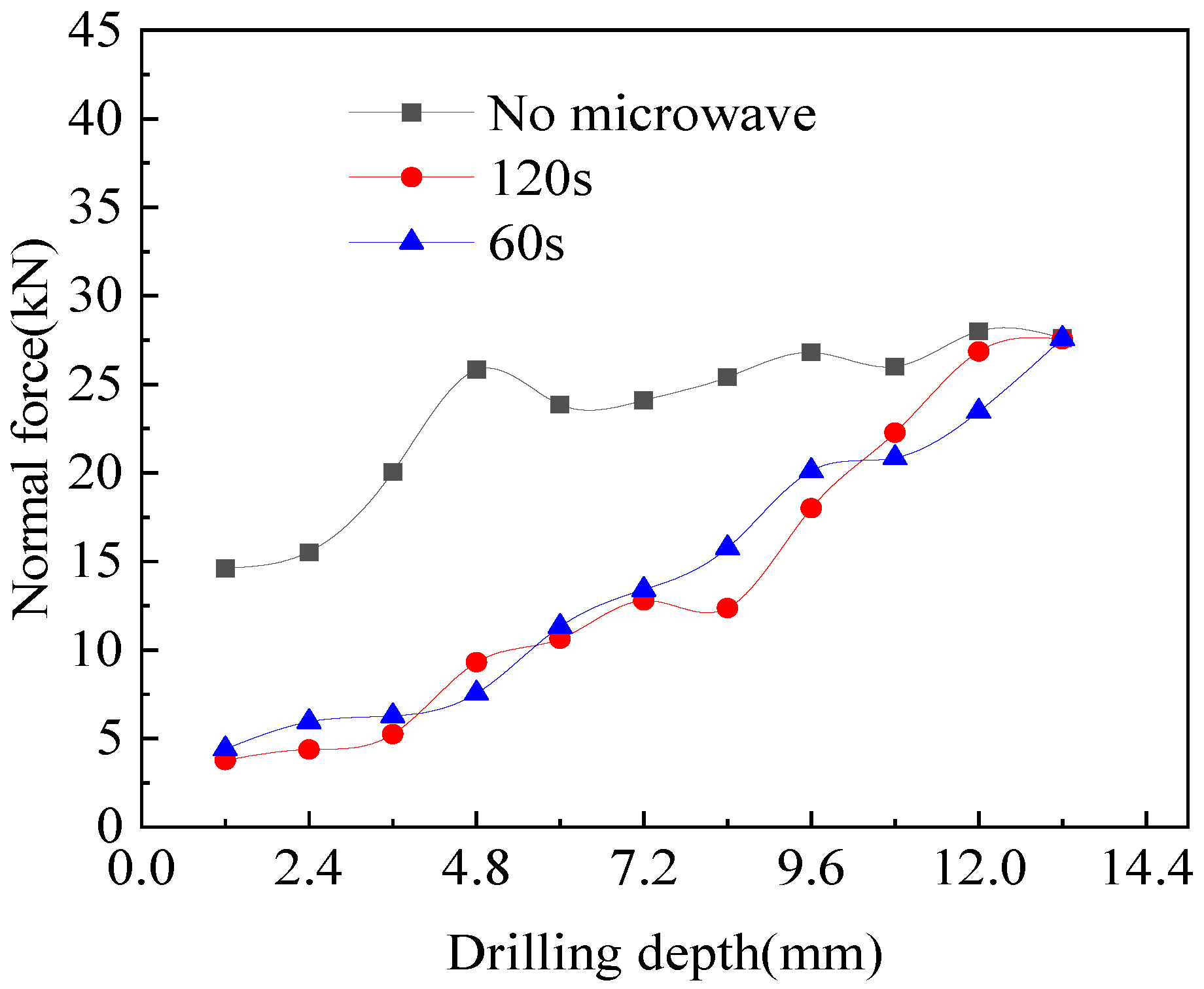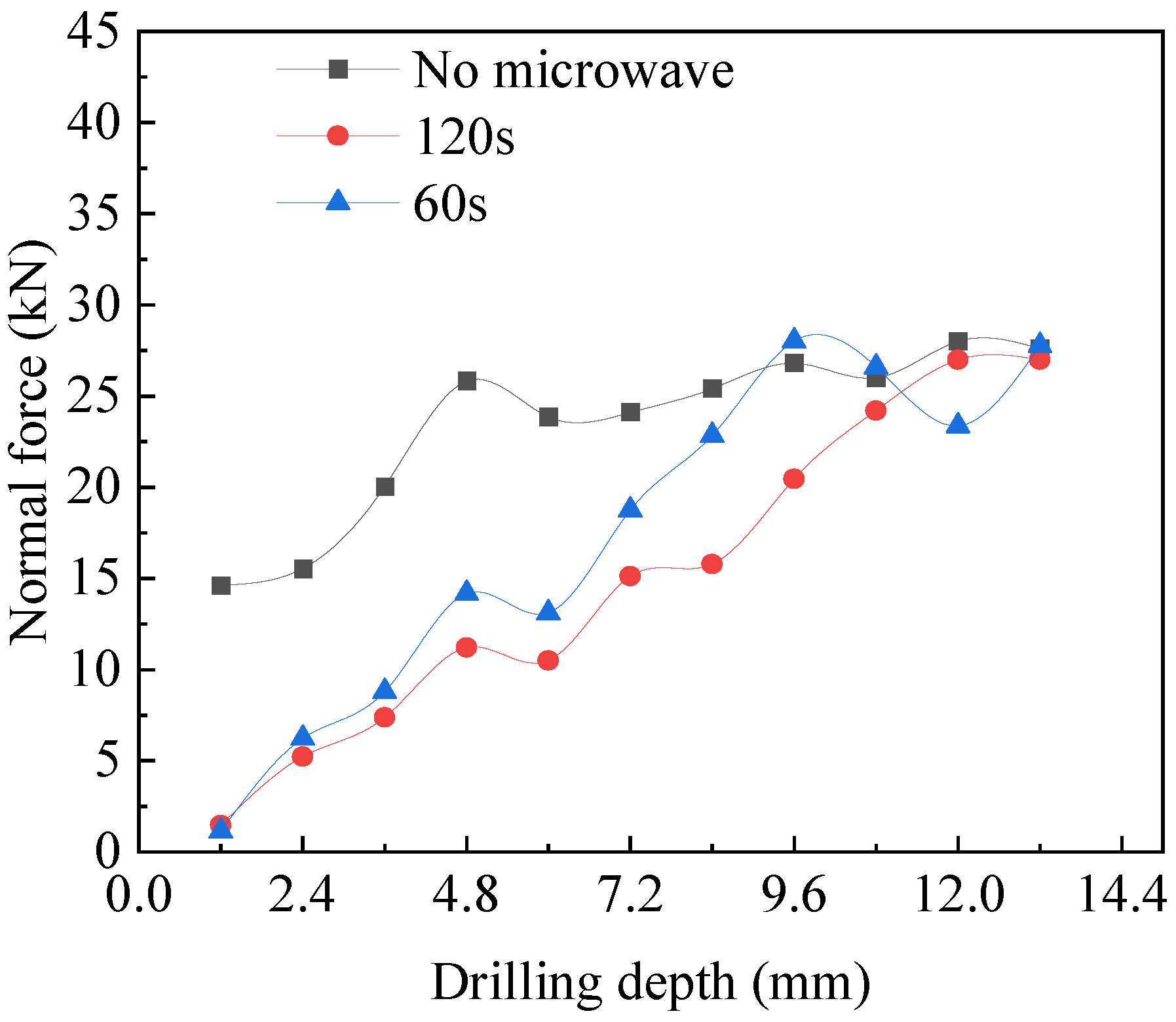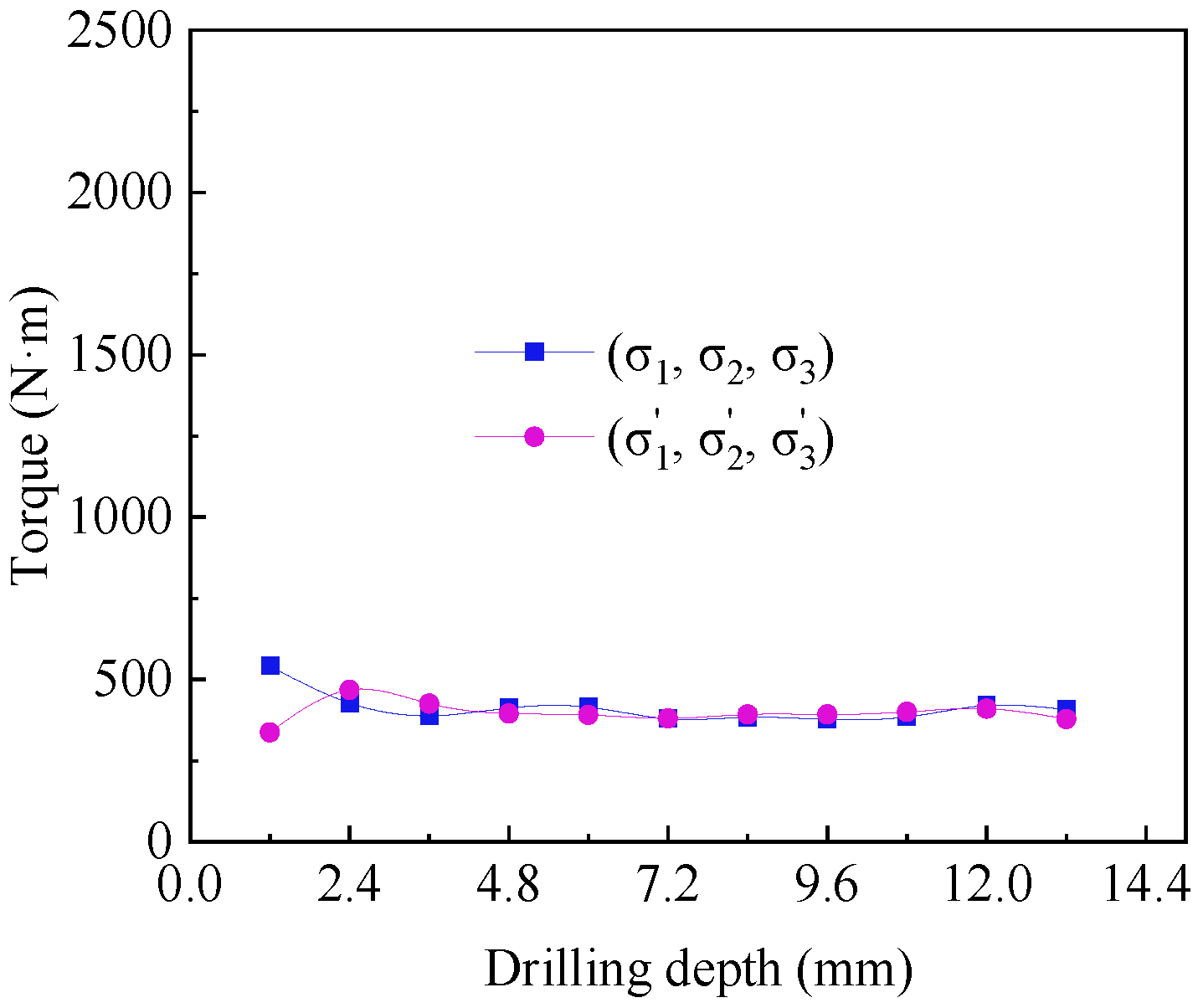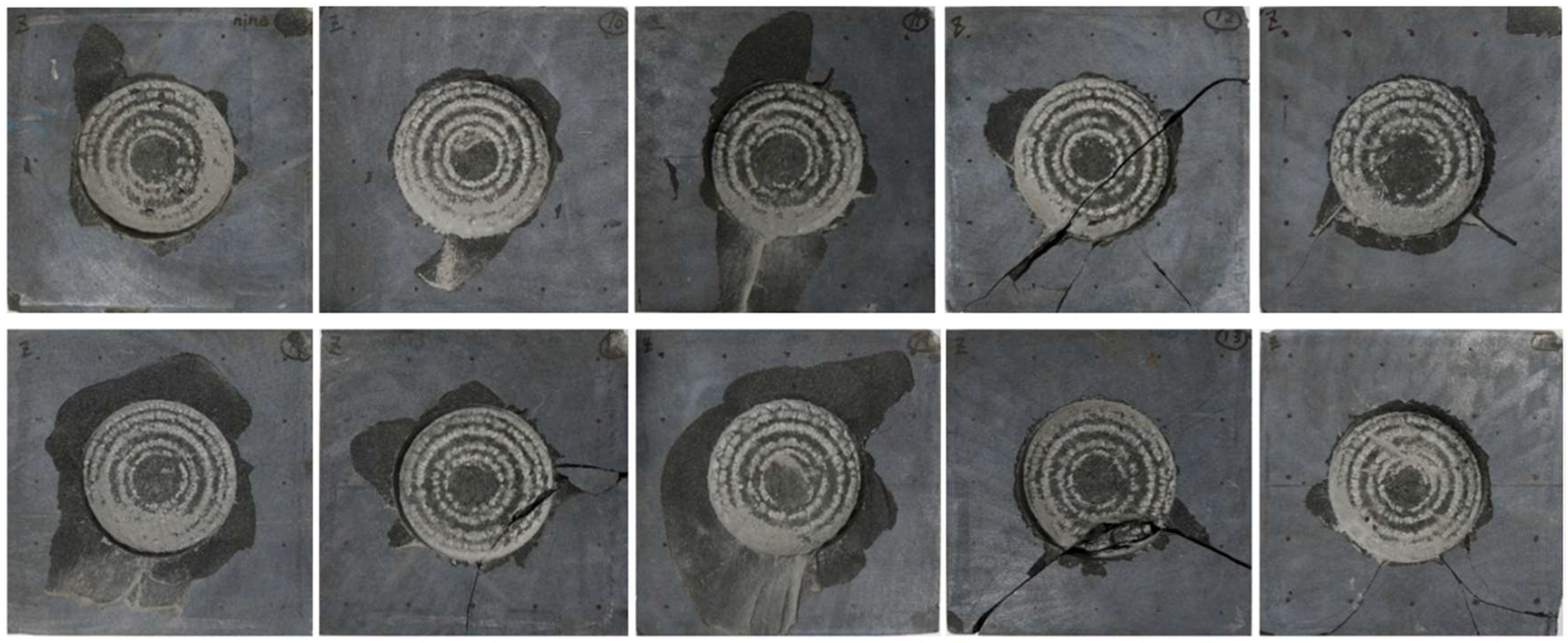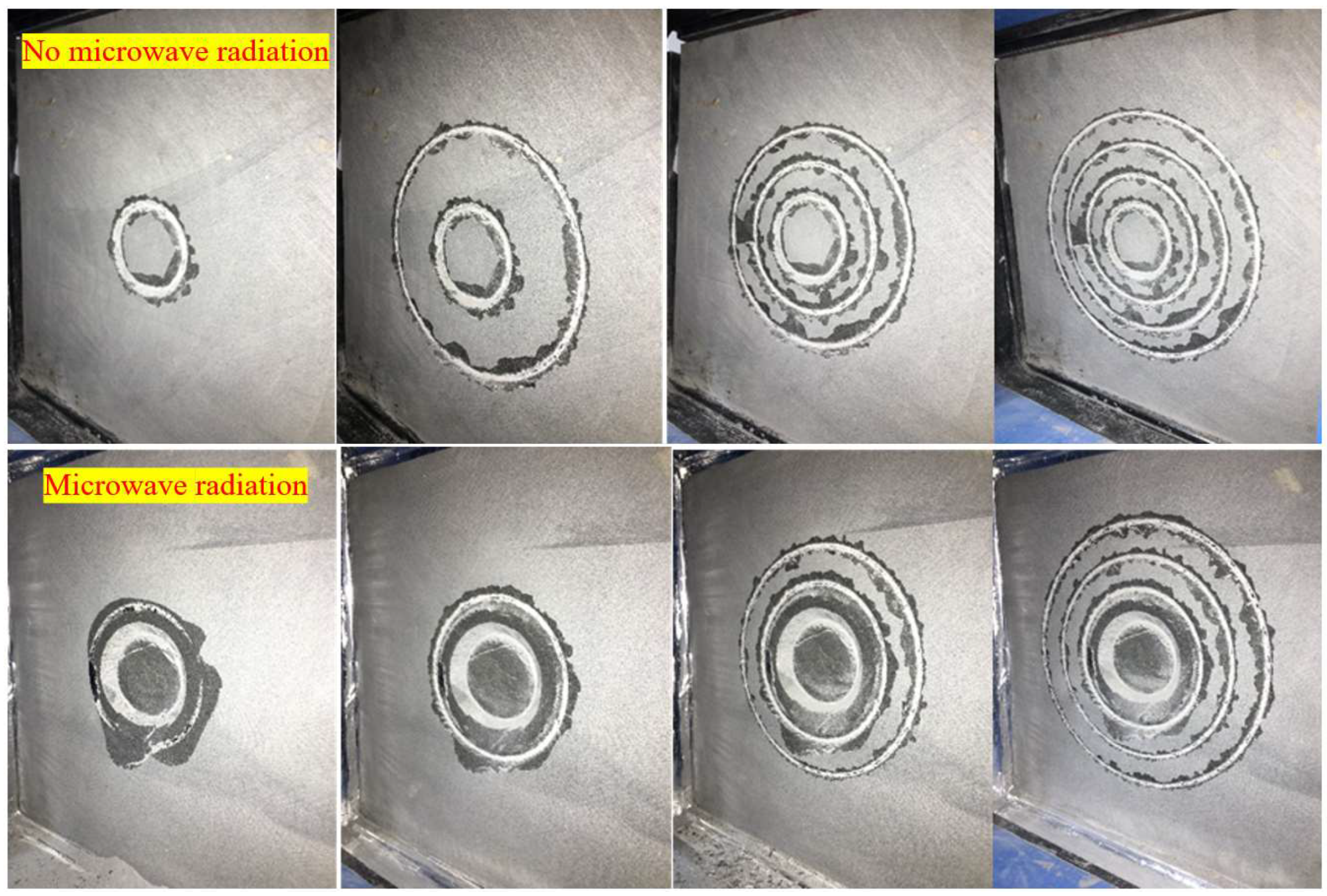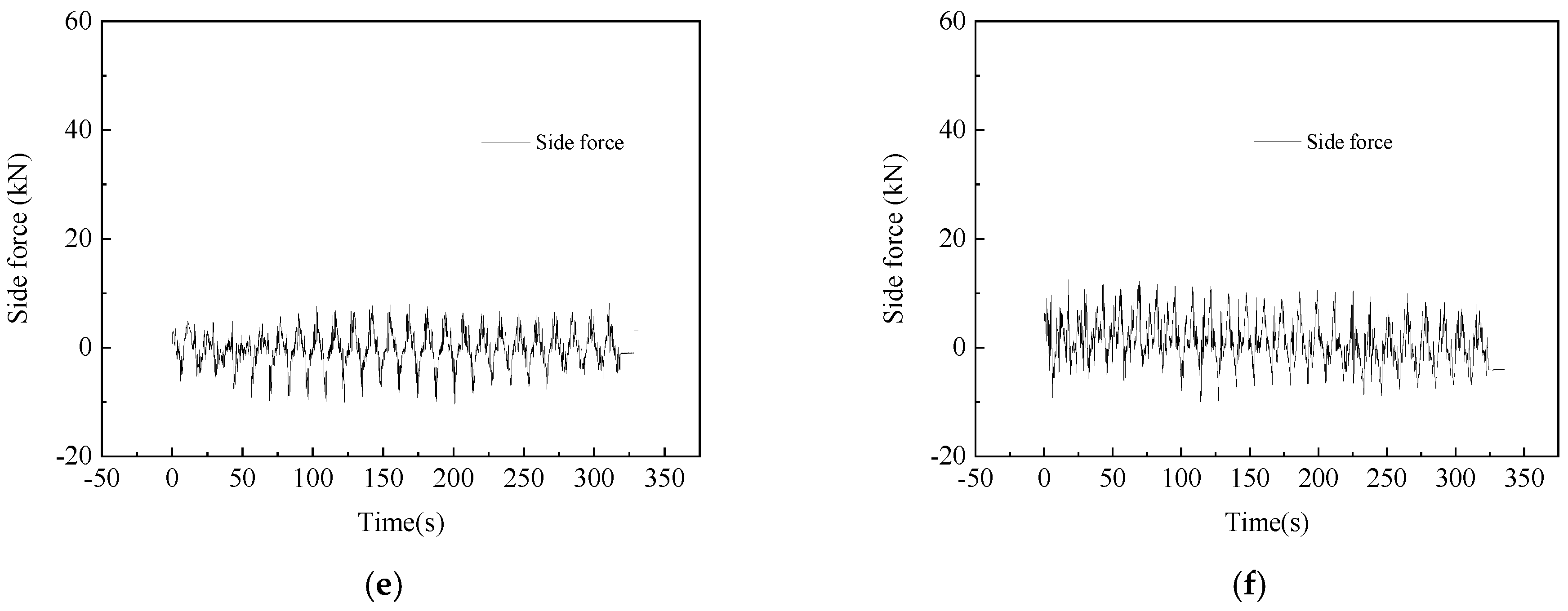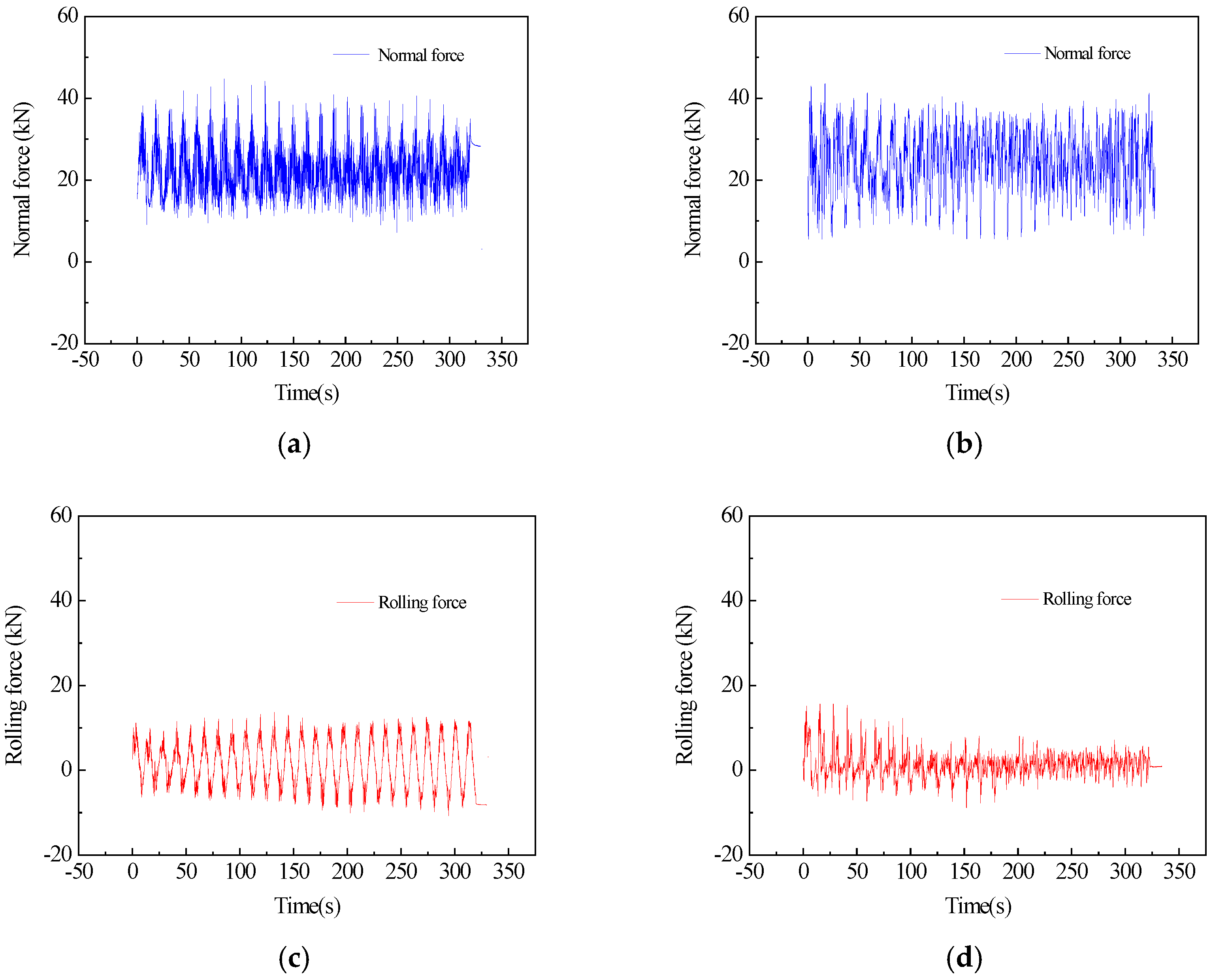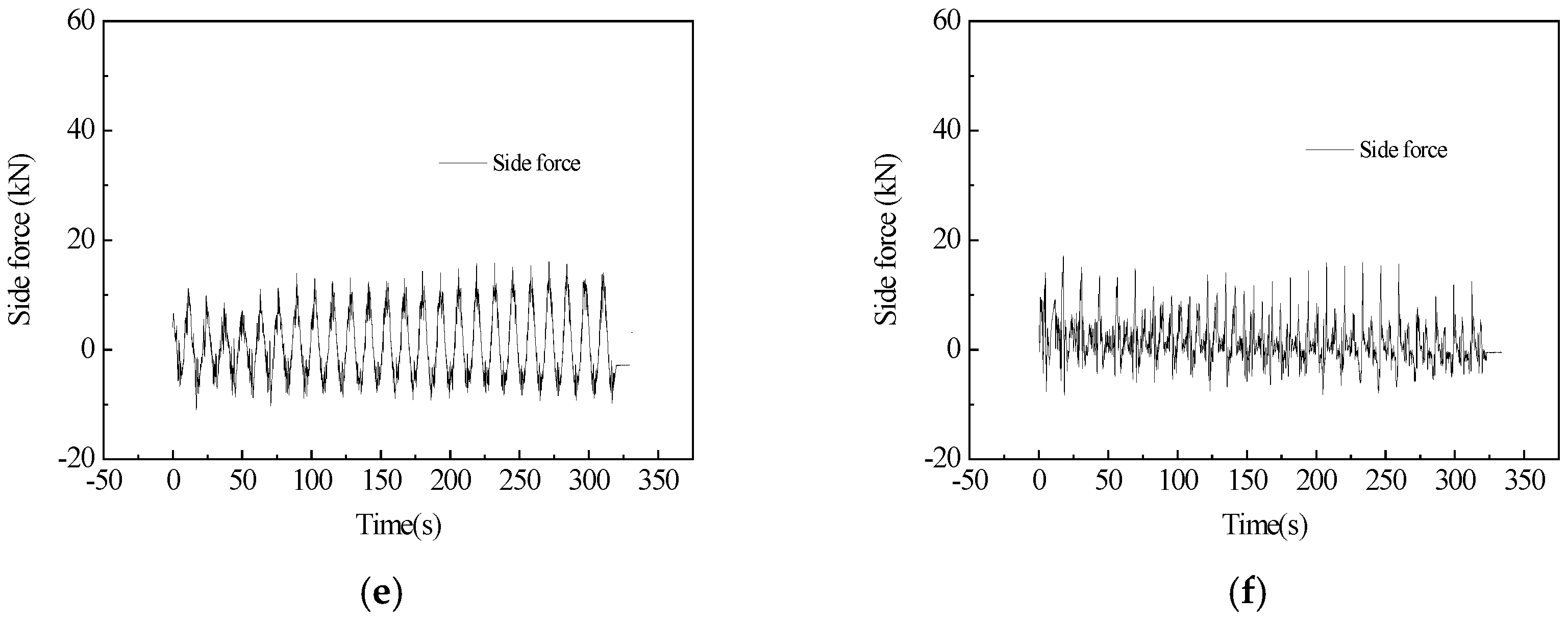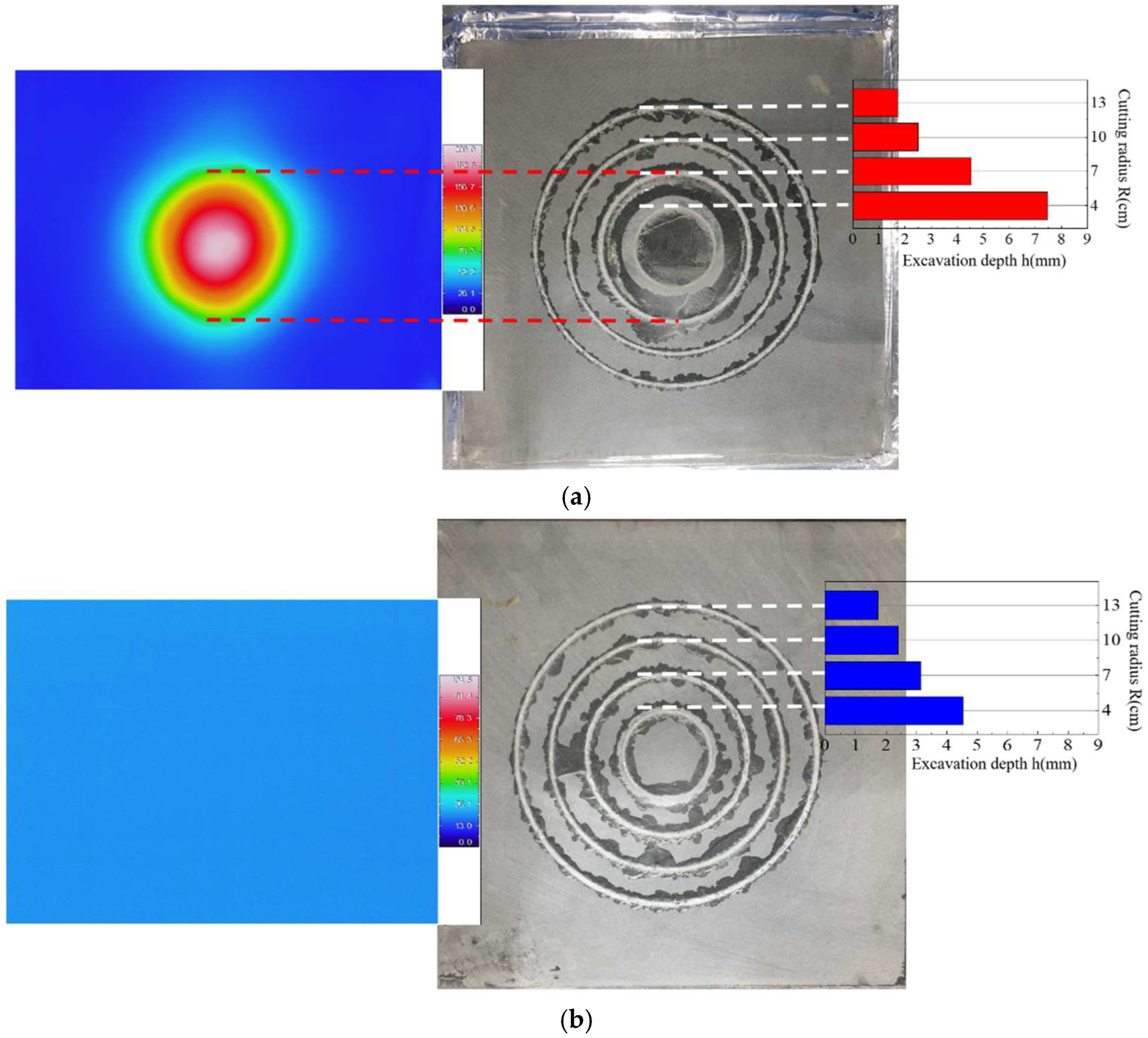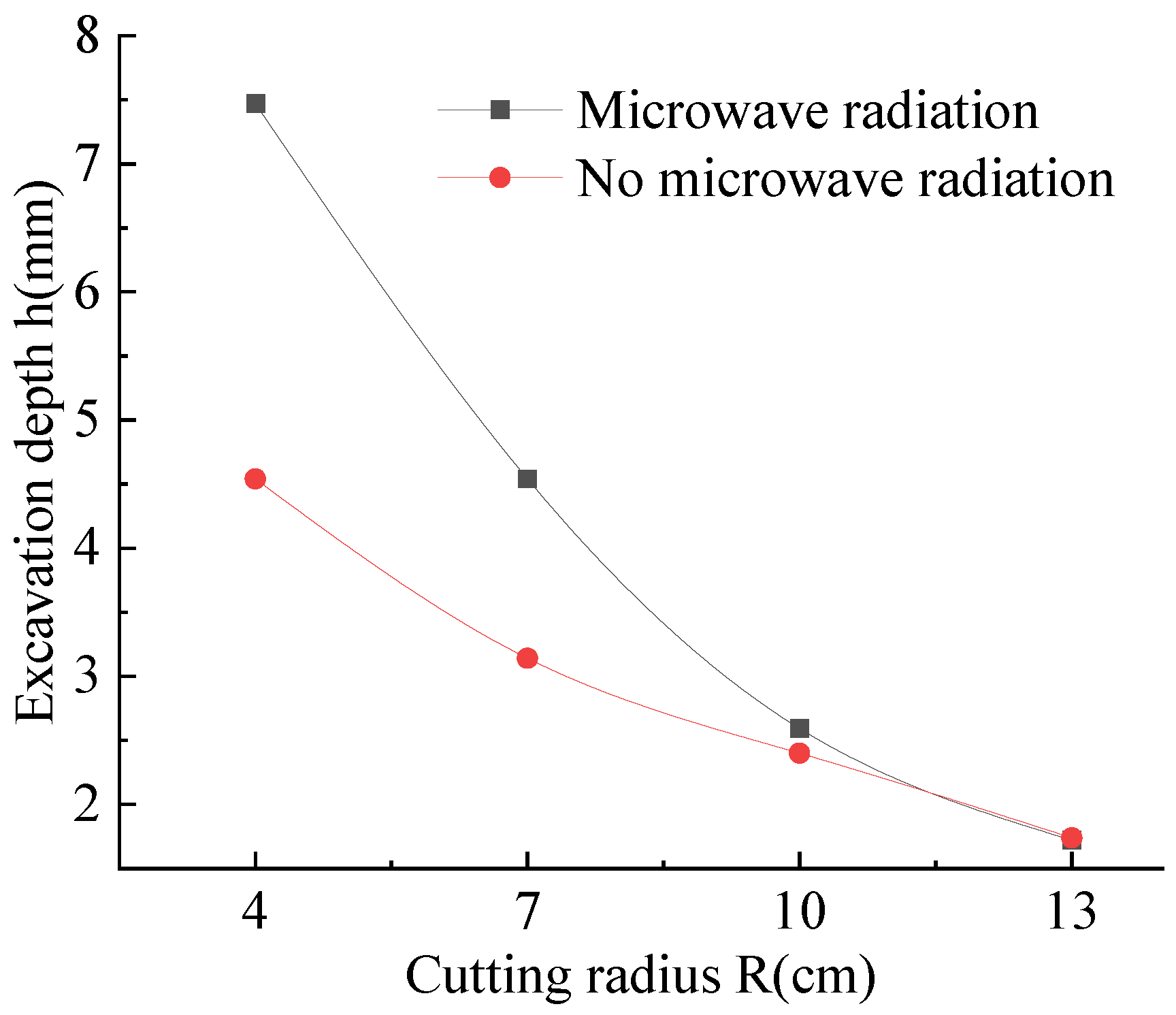4.1. Cutting Tools Used Under Different Microwave Irradiation Times and Stresses
Due to the fact that the initial excavation force value of the drill bit is at its maximum when a fixed penetration degree is set. This value drops sharply in a short period of time; the maximum stable operating load of the drill bit is about 80 kN based on the characteristics of the excavation force of the drill bit, according to the above drill bit test. Under the condition of fixed penetration, the cutting force at the initial rotation is the highest for each penetration depth, and then gradually decreases to a certain value. According to the curve illustrating normal force pertaining to the drill bit at different depths of penetration into Chifeng basalt, the corresponding penetration around an applied force of 80 kN is 1.2 mm. Therefore, based on the aforementioned inference, setting the penetration depth of each cycle to 1.2 mm can meet the needs of rock breaking, normal operation of the tool, and other requirements, while also satisfying the need for evaluation of the effective depth of microwave actions.
The drilling method adopted a sequential penetration of 1.2 mm into the rock surface, and then the drill bit was started. After 1 min of rotation, the monitored cutting force dropped to a relatively flat and small value, which could be ignored. Therefore, the main rock-breaking interval occurred within the first minute, and only the average normal force within the first minute was counted. As shown in
Figure 8, the normal cutting force of a single fixed penetration rotary cutting for rock breaking shows an initially high jump, and the subsequent cutting force gradually decreases, but still fluctuates to a certain extent. After the first minute, the cutting force amplitude decreases. Combined with the cutting state, the vibration and cutting sound of the machine body are reduced to a low level, and the contact between the tool and the rock shows slip. Therefore, the cutting force is compared by taking the average value within the first minute.
Under the condition of true triaxial high force (burial depths), the cutting force without microwave irradiation is higher than that of the rock after microwave irradiation before the excavation depth of 9.6 mm is reached within the same time. Compared to low-stress conditions (
Figure 9), the depth of influence of microwaves under high-stress conditions is shallower. Moreover, the cutting force during the initial cutting under high-stress conditions is smaller compared to that under low stresses, indicating that the range of influence of microwave-induced cracking shifts forward under high-stress conditions.
Results of microwave irradiation at 60 s and 120 s under high stresses in the true three directions, indicate that the initial cutting forces are similar. This is because at the position of the rock surface, the degree of fracturing at 60 s and 120 s is similar, indicating that under this condition, the surface layer to a depth of 1.2 mm has reached fracturing saturation by microwave irradiation at 60 s. As the excavation depth increases, the advantage of microwave irradiation for 120 s becomes prominent. Specifically, the difference in cutting force between 120 s and 60 s increases. It is not until reaching an excavation depth of 11 mm that the two reach similar values again. This law also evinces the general characteristics of microwave fracturing. The degree of fracturing decreases from the rock surface to the interior of the rock, and the cutting force decreases within the effective influence depth. However, beyond the effective zone of influence, cutting force shows no significant change.
Figure 10 illustrates that under deep high-stress conditions, an irradiation duration of 120 s reduces the cutting efficiency of the tool in rock breaking within the effective influence range, indicating that increasing the duration of microwave irradiation is beneficial for the rock-breaking performance of the tool. Under these conditions, the duration of microwave irradiation exerts little effect on the effective depth of influence on rocks.
As shown in
Figure 11, after 60 s of microwave irradiation, the initial torque under deep high-stress conditions is relatively large at 2176.5 N·m. When excavating to a depth of 2.4 mm, the torque drops significantly to 446 N·m. In the subsequent continuous excavation, the torque changes relatively steadily, with a threshold fluctuating in a small range between 204.85 N·m and 413.17 N·m. Under low stresses, the initial torque is slightly higher than that in the subsequent excavation process, but the trend is not obvious. The overall trend in the torque indicates a relatively gentle change, and the torque threshold fluctuates between 195.12 N·m and 312.52 N·m, so the overall torque under high-stress conditions is higher than that under geostress conditions. Under deep high-stress conditions, the normal cutting pressure is relatively small and the torque is large, which proves that the high stress is helpful for breaking of the microwave-assisted rock surface, but not conducive to cutting of the TBM edge rolling cutter and overall support of the shield.
As shown in
Figure 12, after 120 s of microwave irradiation, there is no significant difference in torque between deep high-stress conditions and shallow low-stress conditions. Under high-stress conditions, the cutting torque slowly decreases from 541.95 N·m, and drops to 427.76 N·m when excavated to 2.4 mm. The subsequent torque fluctuation threshold ranges from 392.66 N·m to 415.12 N·m. Under low-stress conditions, the initial excavation torque is 337.09 N·m, which first increases to 468.52 N·m, then decreases to 426.12 N·m. The subsequent changes are also relatively gentle, with a threshold ranging between 378.46 N·m and 395.61 N·m.
The influences of different durations of microwave irradiation were expounded thus: when the microwave was irradiated for 120 s, the cutting normal pressure under deep high stress was small, and the difference between the torque values was small. Combined with the microwave of this rock, the collapse stopped between 90 s and 120 s. Therefore, subsequent experiments used irradiation for 120 s to prove the relationship between different burial depths, cutting forces, and microwave energy.
4.2. Analysis of Microwave-Combined Mechanical Rock-Breaking Test Results at Different Burial Depths
After microwave irradiation, rock fragments were peeled off from the surface of each rock (
Figure 13). When the true triaxial stress is small, the overall span of rock fracture is small. When the burial depth is shallow (i.e., the true triaxial stress is small), the irradiation surface is mainly concentrated near the center of microwave irradiation for fracture. As the burial depth increases, the peeling area of the irradiation surface gradually enlarges. Especially when the burial depth exceeds 1400 m, the peeling area expands significantly. From the microwave-induced fracturing effect, it can be seen that the true triaxial stress grows with the increase in the burial depth, promoting the rock-breaking effect on the surface. It can also be considered that as the stress difference (
σ1 −
σ3,
σ1 −
σ2) increases, microwaves promote the peeling of the rock surface.
As shown in
Figure 14, each rock is drilled at the center, with a temperature rise of about 200 °C. During the initial excavation of the drill bit, the front section of the drill bit is uniformly pressed against the blasting pit, and the position of the blasting pit subject to this pressure at this time is considered as the rock surface during the initial excavation stage. Through the monitoring of drill-bit excavation, in the initial excavation stage, the normal force acting on the drill bit fluctuates greatly, gradually stabilizes, and finally decreases albeit while undergoing slight fluctuations around zero. After microwave irradiation in each group of rocks, the drill bit is drilled and cut, and the initial cutting position is based on the tool contacting and pressing against the free face of the sample. Due to the characteristic of microwave-assisted mechanical rock breaking, which is the initial condition of rock surface breaking caused by microwaves, the initial cutting position of subsequent experiments, including single rolling cutters and integral cutter heads, is taken as the initial position when the tool comes into contact with the rock. The tool-cutting process was then conducted on all rocks after microwave irradiation.
According to
Figure 15, as the burial depth increases, the overall normal force of rock breaking tends to increase, and the cutting force on each group of rocks also increases with increasing excavation depth. At a burial depth of 200 m, the average cutting force on each section without microwave cutting is higher than that under corresponding microwave irradiation conditions. Moreover, when the cutting depth is 12 mm to 13.2 mm, the cutting force without microwave overlaps that needed at 2600 m and 2000 m. Therefore, it can also be proved that, beyond the cutting depth of 13.2 mm, it represents, or may be classified as, the original rock zone, and the influence of microwave irradiation is relatively small.
The distribution pattern of microwave-combined mechanical rock breaking under overall conditions was analyzed, as shown in
Figure 16. Simulation experiments from a burial depth of 200 m to a burial depth of 2600 m showed that the cutting force was 10.76 kN at 200 m, followed by an increase in the average normal force cutting force to 13.59 kN at 800 m, and then a decrease in cutting force compared to 800 m, reaching 12.84 kN at 1400 m, and then an increment of cutting force again, reaching 16.98 kN at 2000 m. According to the fitted curve, the cutting force peaked at about 17.50 kN at 2150 m and then decreased again, reaching 16.37 kN at 2600 m. Therefore, in the experiment, the overall cutting force showed an increasing trend. There is a fluctuating trend between different stages: in particular, between a burial depth of 800 m and 2600 m, there are frequent fluctuations, during which the driving force of the tunneling machine can be adjusted accordingly with the burial depth. In the absence of microwave irradiation, the changes in cutting force tend to be similar to those under microwave irradiation.
4.3. Experimental Investigation of Microwave-Combined Single Roller Rotary Cutting
Research involving microwave irradiation combined with TBM rolling cutter rotation is another important link used when analyzing the mechanism and law of rock breaking under the combination of microwave irradiation and rolling cutters. Using rolling cutters to cut with different rotation diameters near the center of microwave irradiation helps to analyze the effective range of circumferential influence of such irradiation and plays an important role in influencing the cutting force or cutting efficiency of rolling cutters.
As shown in
Figure 17, a 4-inch (102 mm) single-blade rolling cutter was used to gradually cut and roll the microwave irradiation area after microwave irradiation. Considering that the rolling cutter has already cut the microwave irradiation center point during linear cutting, and the high-temperature zone in the center area of microwave irradiation has a certain area, the cutting ring during rotary cutting cannot pass through the center of microwave irradiation. Therefore, the cutting radius of the rolling cutter was set to 40 mm, 70 mm, 100 mm, and 130 mm, respectively. By using a single rolling cutter to roll in the center of microwave irradiation, the cutting force near the center of microwave irradiation could be analyzed to ascertain whether the cutting force and shape are consistent, and the degree of microwave-induced damage to rocks in different ranges (widths) before and after microwave irradiation can be judged by the pushing efficiency. The setting of the cutting path and radius refers to the high-temperature area on the rock surface. To eliminate the difference in total cutting distance caused by different cutting paths of the rolling cutter, it is necessary to convert the total cutting path of the rolling cutter into a corresponding cutting time according to different cutting radii. The cutting time of the inner ring must be greater than that of the outer ring to equalize the total cutting distance both inside and outside. Under the equidistant conditions, the cutting force and cutting depth at different distances from the center of microwave irradiation should be compared. To verify the issue of increased energy required during the cutting process of microwave-irradiated tools under stress-free conditions, a 4-inch (102 mm) single-blade rolling cutter was adopted to cut the area around the microwave-irradiated high-temperature ring from the inside out in a step-by-step manner.
The basalt samples were cut without, and after, microwave treatment from the inside to the outside, with an initial pressure of the cutting oil source set to 20 kN and a cutting spacing of 30 mm. The diameters from the innermost to the outermost circle are 80 mm, 140 mm, 200 mm, and 260 mm, respectively. The captured infrared cloud map indicates that the diameter of the temperature zone above 104.7 °C is about 140 mm, meaning the diameter of the basalt rock flakes peeling off is about 140 mm. From the perspective of cutting depth, the rock without microwave has the deepest inner ring depth and the shallowest outer ring depth. This is due to the different rolling and lateral forces experienced by the rolling cutters of the inner and outer rings. The cutting depth of the rock after microwave irradiation is higher from the inner to the outer ring than that without microwave irradiation. Comparing the cutting effect and monitoring parameters with and without microwave irradiation, microwave energy is found to have a more obvious auxiliary effect on cutting, and the auxiliary function is stronger with increasing proximity to the center of the cut.
The single-blade cutting test can not only verify the effect of microwaves on rock pre-cracking, but also validate the range of microwave action. If the axial force applied in each rolling cutter cutting (hereinafter referred to as the first to fourth cutters from the inside out) is analyzed, it can be found that the vibration amplitude of the cutting force of the first cutter is small due to the small radius of rotation. The rolling cutter repeatedly crushes the rock surface, forming shallow grooves, but at this time, it is not in a rock-breaking state. When the rolling cutter ring rolls forward to break the rock, it will encounter rock particles or mineral particles, which together form a rock-breaking point. That is, the rolling cutter cuts off these points with a relatively high strength and hardness, and then completes a rock-breaking action. The corresponding force value will also fluctuate. At the same time, when the rock pieces or small particles in the direction of rolling force and lateral force are cut off, rolling occurs. The force will also reduce accordingly, so the upper and lower threshold values of the axial force monitored are set as the rock-breaking force threshold for the rock surface; that is, forces greater or less than this threshold range are all in a rock-breaking state. The first cutting threshold is [13.09, 33.42], with critical values of 13.09 kN and 33.42 kN, respectively. Therefore, force values below 13.09 kN and above 33.42 kN are both rock-breaking forces, while forces outside this range are in a rock-breaking state. Applying this threshold to the analysis of rock-cutting values without and with microwave irradiation, it can be found that there are more rock-cutting points after microwave treatment, and the rock breaking is more intense in the initial stage of cutting. The rock-breaking force then gradually decreases, indicating that the cutting effect gradually decreases as it advances into the rock. At about 140 s, the cutting force drops below the threshold, and after about 150 s, the cutting gradually increases again, reaching the value of the initial rock-breaking force. After 250 s, the amplitude of the rock-breaking force value is not large and tends to stabilize.
- (1)
The amplitude of three-dimensional force fluctuations before microwave irradiation is larger, forming a more apparent contrast with that after microwave irradiation. From the frequency of force fluctuation, the vibration is more concentrated after microwave irradiation, and the vibration is more dispersed when no microwave irradiation occurs, which is unfavorable for the performance of the rolling cutter. Therefore, the effect of microwaves is more apparent near the center of microwave irradiation.
- (2)
The normal force after microwave irradiation more significantly increases in amplitude compared to that without microwave irradiation, but the amplitude of the increase is smaller than that of the first cutting ring, indicating that microwave irradiation exerts a smaller influence on the second cutting ring than on the first cutting ring. However, the rolling force and lateral force still significantly fluctuate after microwave irradiation, and the amplitude of such changes is similar to those of the first cutting ring. In addition, the influence of microwave irradiation on the lateral force and rolling force of the second cutting ring is greater than that of the normal force, indicating that the range of influence of microwave energy in the width (areal) direction is larger than that in the longitudinal (depth) direction. This suggests that the failure induced by microwave irradiation entails surface cracking rather than deep cracking.
- (3)
The cutting of rocks without microwave irradiation in the third cutting process showed rock breaking from beginning to end, and values below and above the threshold range exhibited a relatively uniform distribution. However, rocks irradiated with microwaves also had situations outside the threshold range from beginning to end. The cutting force of the two only fluctuated in an orderly manner around the average value and the maximum value above and below the threshold throughout the entire process. Combined with the cutting effect, it can be found that the change in force exerted on the rock with and without microwave irradiation in the third cutting circle of the third cutting is insignificant, as is the difference in the distribution of force around the threshold value between the two. In terms of cutting effect, neither of them has a good cutting effect. Therefore, the difference in the influence of microwave action on the third cutting circle is insignificant. The depth of cutting penetration varies, indicating that the influence of microwave irradiation has been greatly weakened within the range of the third cutting ring.
- (4)
The situation of the fourth cutting ring is similar to that of the third cutting ring. At this time, the rolling cutter is located at the outermost ring, and under the same angular velocity, the outer ring has the highest linear velocity and the rolling distance of the rolling cutter is the largest. The two groups of rocks on this cutting path exhibit similar cutting effects, and the axial force fluctuates similarly around the upper and lower threshold values. This finding shows that the further from the center of microwave irradiation, the smaller the influence thereof.
Therefore, comprehensive cutting tests were conducted on the surrounding area of the high-temperature zone caused by microwave irradiation to demonstrate the properties of the microwave cracking zone in various directions, and to prove whether microwave irradiation in various directions has specificity and discreteness.
Figure 22 shows the cloud map illustrating the high-temperature region of microwave waveguide irradiation.
According to the experimental results (
Figure 23), the diametral range of the microwave-induced high-temperature area (≥150 °C) is about 150 mm, and the diametral range of the microwave-induced high-temperature area (≥100 °C) is about 200 mm under the respective prevailing conditions. There is significant rock peeling after cutting in the middle of the area under microwave irradiation. The cutting effect on the rock surface under microwave conditions is relatively complete, only forming a series of concentric rings. There is only a small amount of rock debris peeling on both sides of the cut, and the degree of rock debris peeling on both sides of the inner and outer rings is similar. The cutting and excavation depth of the rock surface after microwave irradiation is significantly increased on the first and second rings. At radii of 100 mm and 130 mm, the microwave irradiation effect is similar to the excavation depth without microwave irradiation. This means that the microwave irradiation effect is more significant within the radius of 100 mm, and insignificant beyond that.
